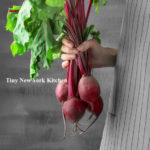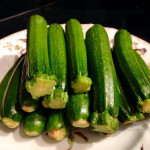Heart healthy beets are packed with nutrients and are perfect for late winter meals. You will love them for their vibrant color, sweet flavor, and versatility.
There are just 60 calories in 1 cup of beets. While low calorie, beets are also packed with potassium, iron, vitamin C, and heart healthy nitrates. The greens are rich in vitamins A and K. Try using beets in soups and sautés.
While red beets are the most common variety, other varieties of beets do exist. Golden beets, as their name implies, are a golden yellow color. Chioggia beets contain red and white stripes on the inside, which is why they are often referred to by their nickname – candy cane beets.
To store fresh beets, separate the leaves from the root and place in separate plastic bags in the refrigerator. The greens should be used within a few days while the roots can last up to two to three weeks.
To peel uncooked beets, use a vegetable peeler to remove the thin skin. For roasted beets, use a paper towel to gently rub off the skins. This gives you a better grip and helps keep beet juice from staining your hands.
Beet juice has been used as far back as the 16th century for makeup, hair dye, and fabric dye. It’s still used commercially as a natural food coloring and clothing dye.
To remove beet juice stains from your cutting board, sprinkle with salt and rub with a lemon half before rinsing. You can remove stains from your hands by rubbing them with a little baking soda, then washing with soap.
Beets are high in nitrates, natural compounds that may help lower your blood pressure and help your body use oxygen more efficiently. Many pro athletes and Olympians drink beet juice to improve their performance.
Beets get their deep red color from compounds called betalains, which have strong antioxidant and anti-inflammatory properties.
37% of the recommended daily intake of folate for adults is in 1 cup of raw beets. Folate needs increase during pregnancy, as this vitamin helps babies develop in the womb, making beets a great addition to a pregnant woman’s diet.
©Tiny New York Kitchen © 2021 All Rights Reserved
Is there anything better than ripe, juicy summer tomatoes? Tomatoes shine in salads, as toast toppers, and in pasta.
Heirloom tomatoes are grown from seeds that have been passed down through generations and are not modified in any way. They come in hundreds of varieties.
The tomato is technically a fruit because it contains seeds. Still, in 1893, the U.S. Supreme Court ruled to classify it as a vegetable since that’s how it is used in cooking.
Unripe tomatoes won’t ripen in the fridge. Keep them on your counter until they are ready to eat.
The first tomatoes to arrive in Europe were called love apples, apples of paradise and golden apples. Some were considered too pretty to eat and used as table decorations.
22 pounds of tomatoes are eats per person per year in the U.S. About half of that comes in the form of ketchup and tomato sauce.
30,000 is the number of tomatoes produced in one year by the world’s largest tomato plant. They were grown in the greenhouses at Disney World.
25% of your recommended daily amount of vitamin C is in 1 medium tomato. Tomatoes are also high in vitamin A, vitamin E, and lycopene (an antioxidant that can improve your heart health and lower your cancer risk.
“Work With What You Got!”
©Tiny New York Kitchen © 2020 All Rights Reserved
The orange carrot we know and love today came originally from Holland, but up until the Middle Ages, all carrots were purple. Gardeners often delight in such oddities, but you will be very lucky to find any purple specimens available in stores or supermarkets.
Carrots contain large amounts of carotene and vitamin A, along with useful amounts of vitamins B3, C and E. When eaten raw, they also provide potassium, calcium, iron and zinc, but these are partly destroyed with cooking.
Almost all vegetables have a better flavor if they are grown organically, but this is particularly true of carrots. If possible, buy organic ones, or look for the young, pencil-thin carrots that still have their feathery tops attached. These young carrots can be eaten raw, or steamed for a few minutes. Older carrots should be unblemished and feel firm. Carrots should not be stored for too long, but they will keep for several days in a cool airy place or in the salad drawer of the refrigerator.
The age of carrots is a guide to how they should be prepared. The valuable nutrients lies either in or just beneath the skin, so if the carrots are young, simply scrub them. Medium-size carrots may need to be scraped with a knife before cooking them and large carrots will need to be scraped or peeled. Carrots can be cooked or eaten raw. To eat raw, they can be cut into julienne strips and tossed with a dressing, or grated into salads and coleslaw. They can bee cooked in almost any way you choose. As an accompaniment, cut them into julienne strips and braise in butter and cider. Roasted carrots are delicious, with a melt-in-the-mouth sweetness. Par-boil large ones first, but younger carrots can be quickly blanched or added direct to the pan with a joint of meat.
“Work With What You Got!”
© Victoria Hart Glavin Tiny New York Kitchen © 2017 All Rights Reserved
Baby Zucchini
Baby zucchini are very tender, tasty simple vegetables that have more flavor than the larger Italian zucchini as well as being very easy to prepare and enjoy. Archeologists think that they are indigenous to Central America. They are very nutritious and are a good source of Vitamin A, C B6, thiamin, niacin, and Pantothenic acid. Baby zucchini are also a very good source of fiber, protein, folate, iron, magnesium, phosphorus, zinc, and copper.
Quick Roast: Cut lengthwise and roast with sliced onions for 25 minutes at 350 degrees.
Blanching: Drop zucchini into boiling water for 1 to 2 minutes. Then remove to an ice bath. Zucchini are now ready to cut lengthwise and add to salads, sauté with mushrooms, onions, and garlic.
Grilling: Brush zucchini with olive oil, sprinkle with fresh herbs or spices, and either grill on BBQ or grill in a grill pan for about 2 to 3 minutes on each side.
Microwave: Place zucchini in ziplock bag. Cut corner of bag and microwave on high for 3 to 4 minutes.
For Salads: Baby zucchini makes a great salad addition. Shred or grate raw and add to salads, or cut lengthwise and add to vegetable platters.
Raw: To eat raw make sure to wash before eating.
“Work With What You Got!”
© Victoria Hart Glavin Tiny New York Kitchen









